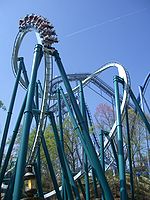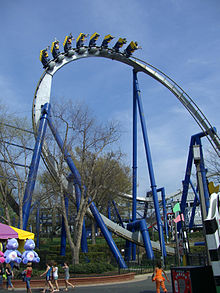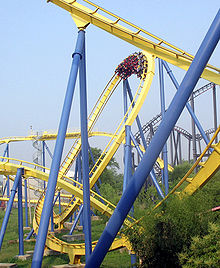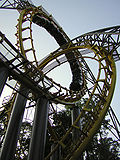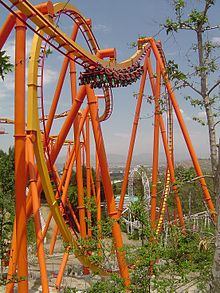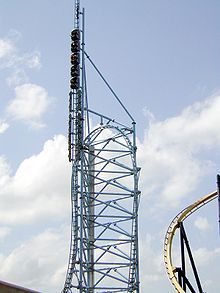- Roller coaster elements
-
Roller coasters are composed of various elements, the individual parts of the design and operation, such as a track, hill, loop, turn, etc. Variations in normal track movement that add thrill or excitement to the ride are often called "thrill elements."
Basic elements
Brake run
A brake run on a roller coaster is any section of track meant to slow or stop a roller coaster train. Brake runs may be located anywhere or hidden along the circuit of a coaster and may be designed to bring the train to a complete halt or to simply adjust the train's speed. The vast majority of roller coasters do not have any form of braking on the train but rather forms of braking that exist on track sections. One notable exception is the scenic railway roller coaster, which relies on an operator to manually control the speed of the train.
On most roller coasters, the brakes are controlled by a computer system, but some older wooden roller coasters have manually operated brakes. These are controlled by large levers operated by the ride operators.
Buzz bars
Single-position lap bars on wooden roller coasters are commonly referred to as "buzz bars," a slang term named for the buzzing sound the bars make as they release. Generally only older wooden coasters and junior wooden coaster trains still use these bars. Most parks have switched to individual ratcheting lap bars, similar to the lap bars found on steel coasters. It can be argued that single-position buzz bars give more air time on roller coasters, as ratcheting lap bars tend to lock further during the ride in many installations.
The traditional "pirate ship" style thrill ride often utilizes this type of restraint, as does the Troika.
Drive tire
A drive tire, or squeeze tire (depending on its usage), is essentially a motorized tire used to propel a roller coaster train along a piece of track. Although they are most often used in station areas and brake runs, they can also be used to launch trains at greater speeds. However, they are generally used to propel the train at speeds between 5-8 mph. The Incredible Hulk Coaster at Universal's Islands of Adventure is notable for using drive tires to launch the train up an incline. Some roller coasters, most noticeably Vekoma Roller Skaters (Vekoma's version of a junior coaster) also use drive tires instead of a chain on lift hills. Drive tires are also used to power other types of amusement rides, such as ferris wheels and other spinning rides.
Drive tires are often used in one of two ways on roller coasters. When oriented horizontally, drive tires are often put in pairs so as to "squeeze" a portion of the train as it crosses that section of track. In this case, it is usually the brake fin that is used to propel or slow the train with the tires. When oriented vertically, they contact the underside of the train as it crosses a particular section of track. This underside area is a flat area which often has a grated metal surface to increase friction between the car and the tire. One disadvantage of vertical drive tires is that rainy weather can greatly reduce friction between the tire and the train, possibly causing the train to slightly overshoot its intended position and cause an emergency stop.
Headchopper
A headchopper is any point on a roller coaster where the support structure of the ride comes very close to the passengers' heads, or at least appears to do so. All headchoppers are, of course, designed so that even the tallest rider, with both their hands up, would be unable to touch the structure; although if a rider exceeding the maximum height does board the coaster it could be potentially dangerous. Headchoppers are most common on wooden roller coasters but are also found on many steel roller coasters.
The inverted roller equivalent is a footchopper. Footchoppers are designed such that rider's legs appear to come close to the ride's support structure, water, or other ride surroundings. Suspended Looping Coasters, such as Vekoma's The Mind Eraser, are known for their footchopper effects because of their compact layout. For example Dragon Challenge at Universal's Islands of Adventure has many footchoppers, where the rider's feet come within feet of the ride's supports. Vekoma's Mind Eraser (and clones) also feature an intense footchopper during an in-line-twist, in which the train approaches a section of track directly below, making it appear that the riders' feet will impact the track if the train remains on that course; but the train undergoes an in-line-twist right before the obstruction, twisting the riders onto their backs as the above track crosses safely over the track below.
Launch track
A launch track is a section of a launched roller coaster in which the train is accelerated to its full speed in a matter of seconds. A launch track is always straight and is usually banked upwards slightly, so that a train would roll backwards to the station in the event of a loss of power.
A launch track serves the same basic purpose as a lift hill—providing power to the train—but accomplishes it in an entirely different manner. A lift hill gives the train potential energy by raising it to the highest point in the track (and not significantly accelerating it). A launch track gives the train kinetic energy by accelerating it to the maximum designed speed (while not significantly raising it).
A launch track normally includes some form of brakes. Depending on the type of coaster, these brakes may be used in every run of the coaster (this is normally found on a shuttle roller coaster where the launch track also serves as the main brake run) or they may only come into play when a rollback occurs, normally on a complete-circuit coaster such as Stealth, Top Thrill Dragster, Kingda Ka, Rock 'n' Roller Coaster Starring Aerosmith and Xcelerator. In either case, the brakes are retracted to allow trains to launch and are engaged at all other times.
Lift hill
A lift hill, or chain lift, is often the initial upward section of track on a typical roller coaster that initially transports the roller coaster train to an elevated point. Upon reaching the top, the train is then disengaged from the lift hill and allowed to coast through the rest of the roller coaster's circuit.
Lift hills usually propel the train to the top of the ride via one of a few different types of methods: a chain lift involving a long, continuous chain which trains hook on to and are carried to the top; a drive tire system in which multiple motorized tires push the train upwards; a cable lift system as seen on Millennium Force; or a linear synchronous motor system as seen on Maverick.
Launch lift hills are like launch tracks, but instead of having it flat, it is rather at an incline. Sometimes, launch lift hills serve the same purpose as lift hills but faster transport to the top of the lift hill; or they are sometimes used to power the train up into an element, like the Incredible Hulk Coaster at Universal Orlando. Launch lift hills use mostly linear synchronous motors or linear induction motors but sometimes use drive tires.
Linear induction motor
The linear induction motor is a simple but powerful type of electric motor used to propel the cars. Rather than using a standard enclosed spinning rotor and drive wheels, there is a long flat magnetic pole plate with closely spaced electric coils. This pole plate mounts on the track underneath the car and a matching metal plate attached to the car moves across the magnetic pole faces. By applying a multiphase alternating current to the poles, the pole plate induces eddy currents into the moving plate and can be used to accelerate or brake the car.
Compared to other drive mechanisms, the linear motor is typically maintenance-free. The pole faces on the track and moving plate attached to the car do not need to touch, and the gap between them can be quite wide to accommodate any side-to-side car motion, so there is no friction or wear between them. Further, the magnetic coil assembly on the driving pole plates are either potted or sealed in a weathertight enclosure, so that rain, vibration, and dust do not affect motor performance or cause drive motor slippage.
On-ride camera
An on-ride camera is a camera mounted alongside the track of a roller coaster that automatically photographs all of the riders on passing trains. They are usually mounted at the most intense part of the ride, to capture the best possible pictures. The pictures are available for viewing and purchase at a booth outside the ride's exit. On some rides, such as the Saw: The Ride at Thorpe Park, and the Sierra Sidewinder at Knotts Berry Farm, video as well as still photographs can be purchased upon exiting the ride.
 El Toro (2006), a wooden roller coaster at Six Flags Great Adventure in New Jersey, uses traditional lap restraint trains.
El Toro (2006), a wooden roller coaster at Six Flags Great Adventure in New Jersey, uses traditional lap restraint trains.
Train
A roller coaster train describes the vehicle(s) which transports passengers around a roller coaster's circuit. More specifically, a roller coaster train is made up of two or more "cars" which are connected by some sort of specialized joint. It is called a "train" because the cars follow one another around the track as a railroad train. Individual cars often vary in design and can carry anywhere from one to eight or more passengers each.
Some roller coasters, notably Wild Mouse roller coasters operate with individual cars instead of trains.
Tester hills
A tester hill or trick hill is any small hill following the lift hill or brake run. The main purpose of a tester hill is to decrease tension and stress on the chain, cable, or other lift used to lift the trains. For example, if a train is hauled up the lift and brought directly to a hill, the force of gravity will pull the trains that are still hooked to the lift. Tester hills usually are followed by a larger hill but sometimes a turn around, giving more of a mysterious feeling.
The name "trick" comes from the fact that these hills also are designed to trick riders into thinking they are at a large hill, causing a "false alarm" element.
Some roller coasters, specifically Wild Mouse roller coasters and launch coasters do not require tester hills.
Thrill elements
Batwing
A batwing is a heart-shaped roller coaster inversion that consists of two loops that turn riders upside down twice. The train goes into a mini-reverse sidewinder, followed by a mini-sidewinder.[1] This inversion is the inverse of a cobra roll.
Like other inversions, the batwing has different names depending on the manufacturer. This element is called a batwing on Bolliger & Mabillard (B&M) coasters, such as Afterburn at Carowinds or Montu at Busch Gardens Tampa Bay in Tampa, Florida. On Arrow Dynamics coasters, such as The Great American Scream Machine at Six Flags Great Adventure, it is called a boomerang.
The first roller coaster to use the batwing element was Orient Express at Worlds of Fun in Kansas City, where it was called a "kamikaze curve." The ride was demolished after the 2003 season.
Another version of the batwing is the bowtie, where the second half of this element is rotated so that the train exits the elements heading in the same direction of travel as at the entrance to the element. Dragon Mountain at Marineland is an example of a coaster with this element.[2]
Butterfly inversion
A butterfly inversion is sometimes found on Vekoma roller coasters. A butterfly begins like a normal loop, but as the track goes up it twists 45 degrees to one side or the other, and then when it is headed down the track twists back. The maneuver is then repeated but in reverse. It is essentially the same in construction as a batwing / boomerang, however the coaster exits the element traveling in the same direction as it began. An example of this is found on Goudurix in Parc Asterix in Plailly, France, or Ninja at Six Flags Over Georgia.
Cobra roll
The cobra roll is a roller coaster inversion which resembles a cobra's head. Riders traverse forward through an upwards half-vertical loop, corkscrew perpendicular to the first direction, enter another corkscrew that merges into a downward half-vertical loop that exits in the parallel but opposite direction of the entrance. It takes riders upside-down twice.
There is much confusion pertaining to the correct naming of this inversion. This is because different roller coaster manufacturers give their own names to inversions. Cobra roll is the standard name used by Intamin and B&M for this type of inversion. The first coaster to use a cobra roll was Vekoma's Boomerang model, the first of which was built in Mexico in the early 1980s. All Vekoma Boomerangs, Drachen Fire, the Tornado at Särkänniemi Park in Tampere, Finland, and almost all B&M 7-inversion coasters have a cobra roll.
 On an Inverted roller coaster riders go through a motion similar to sit-down steel roller coasters. (Batman: The Ride (1999) at Six Flags Over Texas in Arlington, Texas)
On an Inverted roller coaster riders go through a motion similar to sit-down steel roller coasters. (Batman: The Ride (1999) at Six Flags Over Texas in Arlington, Texas)
Corkscrew
A corkscrew resembles a loop that has been 'stretched' in terms of the element's entrance and exit points being a distance away from each other. The main difference is that riders are inverted at a point angled 90° horizontally from the incoming track, whereas in a loop, the inversion comes parallel to the track but traveling in the opposite direction. On Bolliger and Mabillard sit-down, stand-up, and floorless coasters, corkscrews are known as flat spins. On B&M inverted coasters, they are known as wingovers.
It was named because of its resemblance to the corkscrew tool used to remove corks from bottles. Riders enter the corkscrew element and are transported significantly to the left or right while being flipped upside down 360 degrees.
Corkscrews are normally found towards the end of layouts and often exist in pairs. This may take the form of a double corkscrew, where the end of one leads straight into the next. It is also common to see interlocking corkscrews, where the entrances and exits are parallel, but both corkscrews cross over the other corkscrew's track.
Corkscrew is the name of several roller coasters, including a three-loop coaster at Valleyfair in Shakopee, Minnesota, a three-loop roller coaster at Cedar Point in Sandusky, Ohio, a two-loop coaster at Genting Highlands theme park in Malaysia, and a three-loop coaster at Seaworld, Australia. Canobie Lake Park in Salem, New Hampshire has a coaster known as the Canobie Corkscrew.
The first roller coaster with a corkscrew element was the Arrow Dynamics designed Corkscrew, opened in 1975 at Knott's Berry Farm. In 1989, the ride was relocated to Silverwood where it continues to operate.
Bolliger and Mabillard created a variation of the corkscrew, a flat spin. Flat spins begin on flat track and "snap" through the top of the inversion, whereas Arrow and Vekoma coasters use completely curved corkscrews which start on banked track. On an inverted roller coaster, a flat spin is referred to as a wingover.
Cutback
A cutback is a roller coaster inversion similar to a corkscrew except that the two half-corkscrews are in opposite directions so that the train exits the inversion in the same direction from which it entered. The defunct Drachen Fire at Busch Gardens Europe was the only roller coaster to have a cutback inversion. The roller coaster designs today tend to incorporate overbanked turns, which are a more fluid way of performing an exciting turn than cutbacks. Drachen Fire was closed on July 11, 1998, and subsequently demolished. Today, the only two cutback inversions can be found on Space Mountain: Mission 2 in Disneyland Paris and the newly built Sky Rocket at Kennywood Park in Pittsburgh, Pennsylvania.

Diving loop
A diving loop (also, dive loop) is a type of B&M roller coaster inversion whose inspiration was taken from a stunt plane maneuver. Also known as a split S, the track twists upwards and to the side and then dives toward the ground in a half-vertical loop. This element is seen on B&M sit-down, stand-up and floorless coasters. Arrow and Vekoma use a similar element known as a reverse sidewinder. Just as a dive loop is the reverse form of an Immelmann loop, the reverse sidewinder is the reverse form of a sidewinder element (Arrow and Vekoma's version of an Immelmann). It can be seen in Arrow's Cyclone at Dreamworld in Australia and Vekoma's Ninja at Six Flags over Georgia.
Hammerhead turn
A hammerhead turn is based on a flying maneuver by the same name and is similar to, but not the same as, a 180-degree overbanked turn. The train enters the element with a steep slope up and a slight curve in the direction opposite that of the overall turn (a so-called "priming" of the turn). The train then banks heavily to the side opposite the initial curve and finishes its climb while it negotiates the overall turn, beginning its descent mid-way through the turn. The second half of the element is the same as the first half, but in reverse order. While negotiating a hammerhead turn element, the train makes a turn of more than 180 degrees; however, because of the entry and exit curves, the overall effect is that of a 180-degree turn that exits toward the direction from which it entered, roughly parallel to the portion of track preceding the hammerhead turn. Hammerhead turns are found on some B&M hypercoasters. Examples of these coasters are Nitro at Six Flags Great Adventure, Behemoth at Canada's Wonderland, Diamondback at Kings Island.
Heartline roll
 Illustrating a heartline roll, the left is a normal inversion (barrel roll) where the axis of rotation is on the rail center. The right is a heartline roll, where the axis of rotation is (roughly) on the riders' hearts.
Illustrating a heartline roll, the left is a normal inversion (barrel roll) where the axis of rotation is on the rail center. The right is a heartline roll, where the axis of rotation is (roughly) on the riders' hearts.
A heartline roll is a roller coaster inversion in which the rider performs a 360-degree roll. Heartline rolls are commonly confused with inline twists.
In a heartline roll, the center of the train rotates on one axis. The track itself changes in elevation so as to keep the train moving in the same line in which it started the element. In an inline twist, the track with the 360-degree twist remains straight. As such, the train moves downward and then back up during the twist. In some cases, such as Vekoma's Flying Dutchman coaster, the degree to which the train deviates from the line in which it enters the twist is so great, the element is indistinguishable from a corkscrew.
There is also some confusion over the difference between a heartline roll and a zero-g roll. A zero-g roll is basically a standard hill with a 360 degree twist at the top. The trains ascend, twist, and then descend again (providing a brief moment of airtime). In a heartline roll, once again, the trains do not leave the line from which they entered the inversion.
Horseshoe
A horseshoe is a type of turnaround maneuver found on Maurer Sohne coasters. The horseshoe is essentially a 180-degree turnaround with high banking so that riders are tilted at a 90-degree angle or more at the top at the element. The horseshoe is named that way because the element is shaped roughly like a horseshoe, with a semicircular shape at the top. It is found on coasters such as Sonic Spinball at Alton Towers.
Immelmann loop
An Immelmann loop (colloquially, "Immelmann") is a popular inversion found on many roller coasters. In an Immelmann, riders enter a half loop and then go through a half twist and curve out in the opposite direction in which they came. The inversion is very similar to the sidewinder. A sidewinder consists of a half loop and a half corkscrew and comes out closer to 90°, while the Immelman comes out in more of a straight line back to where it started. An Immelmann traveled in reverse is a diving loop. It is most commonly found on B&M inverted and diving roller coasters.
The name "Immelmann" comes from Immelmann turn, an aircraft maneuver named after the World War I German fighter pilot Max Immelmann.
Inclined diving loop
An inclined diving loop is similar to a dive loop, although it is exited at an angle instead of vertically. It is essentially a dive loop that has been tilted. The only two examples are on Hydra at Dorney Park & Wildwater Kingdom and iSpeed at Mirabilandia. This element is also known as the Italian Loop.
Inclined loop
An inclined loop, also known as an oblique loop, is a 360° loop that has been tilted at an angle. It is not entered vertically, like a vertical loop, or horizontally like a helix. Instead, it is usually entered at an angle between 45° and 80°. inclined loops can be found on B&M stand-up roller coasters and Top Fun sit down roller coasters. Examples include: Mantis at Cedar Point; Green Lantern at Six Flags Great Adventure; Riddler's Revenge at Six Flags Magic Mountain; and Georgia Scorcher at Six Flags Over Georgia
Inline twist
An inline twist is a roller coaster inversion in which the rider performs a 360-degree roll. The inline twist is often found on flying coasters, such as Air at Alton Towers, Batwing at Six Flags America, Superman: Ultimate Flight at Six Flags Over Georgia, and Firehawk at Kings Island. It can be confused with a heartline roll. In a heartline roll the center of the train rotates on one axis so the height of the average rider's heart never changes, whereas during an inline twist the train rotates around the track and there is usually little to no elevation difference in the track. Inline twists are sometimes also known as "barrel rolls".
Interlocking corkscrews
Interlocking corkscrews are a type of roller coaster inversion found on B&M coasters. In this inversion, two separate corkscrews spin around each other; one turns riders upside down over the other. Despite being close to each other, the two corkscrews are not necessarily taken consecutively.
Examples of coasters with interlocking corkscrews:
- Nemesis Inferno at Thorpe Park is the only inverted coaster to feature interlocking corkscrews on the same track. (On the another inverted coaster, Dragon Challenge at Universal Studios' Islands of Adventure, one corkscrew on the "Chinese Fireball" track interlocks with the corkscrew on "Hungarian Horntail.")
- Kumba at Busch Gardens Tampa Bay
- Bizarro at Six Flags Great Adventure
- Batman the Ride at Six Flags New England.
- Scream! at Six Flags Magic Mountain
Interlocking loops
Interlocking loops are an element which consists of two vertical loops. This element has been used on only three complete-circuit roller coasters. The first is Loch Ness Monster at Busch Gardens Williamsburg, and the second was Orient Express at Worlds of Fun. A pair of shuttle coasters, Lightnin' Loops at Six Flags Great Adventure, also had interlocking loops. With the closing of Orient Express and Lightnin' Loops, Loch Ness Monster is the only coaster in the world to have this element.
Non-inverting loop
The non-inverting loop is a variety of loop that, when coming up, twists similar to a heartline roll, leaving riders completely straight up when at the top of the loop. To date, the only example is the loop on the Hollywood Rip Ride Rockit at Universal Studios Florida.
Norwegian loop
A Norwegian loop is an element made out of two elements: a dive loop, then an Immelmann; forming an inversion that looks like two side by side loops. This element is similar to the flying coasters pretzel loop, except that the train goes through a twist when entering and exiting the loop. It may also been seen as a normal loop entered from the top. It was first introduced on Speed Monster in TusenFryd, Norway.[3] Another example of a Norwegian Loop can be found on Hersheypark's roller coaster Fahrenheit.
Overbanked turn
An overbanked turn is an element common on large steel roller coasters, particularly those built by Intamin AG of Switzerland. This element is a turn or curve in which the track tilts beyond 90 degrees, usually in the 100-120 degree range. Two examples of an overbanked turn in the United States are the first turn-around on Bizarro at Six Flags New England, and Millennium Force at Cedar Point in Sandusky, Ohio, which features four separate and two consecutive overbanked turns.
Pretzel loop
The pretzel loop is a large inversion found on B&M flying coasters. It consists of a downward half loop and upward half loop . Since they overlap at the top, the entrance and exit points create the look of a pretzel, hence the name. Extreme positive g-forces are induced on riders throughout the duration of the element.
There are six roller coasters that include the pretzel loop: the trio of Superman: Ultimate Flight roller coasters (all 3 of which have the same layout) at Six Flags Great Adventure, Six Flags Over Georgia, and Six Flags Great America; Crystal Wings at Happy Valley (which is also a clone of Superman); Tatsu at Six Flags Magic Mountain; and Manta, at Sea World Orlando.[4] While going through a pretzel loop, the rider is upside down at the beginning and on their back and going backwards at the bottom. The rider then regains normal flying position at the exit of the loop.
Raven turn
A raven turn is a half-inversion which looks like half a loop followed by a drop and then levels out near the same height as it began. The raven turn is only usable on either flying roller coasters or 4D roller coasters at the moment and has only been used on two 4D coasters.[5]
The general term raven turn refers to any inversion that follows the design described above; however, there are two types of raven turns. Assuming the train is going round the half-loop first, an inside raven turn is where the rails are below the train at the start whereas an outside raven turn is one in which the rails are above the train at the start of the element. X² at Six Flags Magic Mountain and Eejanaika at Fuji-Q Highland are examples of raven turns.[6]
Roll out
A roll out is similar to a sidewinder. However, while a sidewinder consists of a half loop followed by a half corkscrew, a roll out consists of a launch into an extended vertical section proceeding into a quarter loop and a loose half-corkscrew. As of 2008, the roll out element is unique to Volcano, The Blast Coaster at Kings Dominion,[7] where it takes the ride to its highest point (155 feet) and is known as the inversion where riders are blasted out of the former Lost World mountain.
Sea serpent roll
A sea serpent roll (Vekoma: roll over) is a roller coaster inversion related to the cobra roll, except the two halves face in opposite directions. It can also be viewed as a reverse sidewinder followed by a sidewinder. The trains exit the track element in the same direction as they entered, unlike a cobra roll in which the trains get turned around 180°.
The sea serpent roll is not as common as many other inversions, like the vertical loop, corkscrew, or cobra roll. It is a common element on most suspended looping coasters. Medusa at Six Flags Discovery Kingdom was the first roller coaster with a sea serpent roll.
Top hat
A top hat (or as known as top cap) is an element common to launched coasters. A standard top hat consists of what is essentially a hill with a 90 degree ascent and descent, the train exits going in the same direction from which it entered. The track twists and the train does not go upside down. Top Thrill Dragster at Cedar Point and Kingda Ka at Six Flags Great Adventure are examples of a top hat.
In a top hat inversion, also called an inside top hat, when the train approaches the top of the "hat", it makes a 90 degree twist so that it is on the inside of the element (hence the name), and once it reaches top hat's apex the train is upside down under the track. Example: The picture to the left shows Mr. Freeze's inverted top hat element.
Vertical loop
Main article: Loop (roller coaster)The generic roller coaster vertical loop is the most basic of roller coaster inversions. Specifically, the loop refers to a continuously upward-sloping section of track that eventually results in a complete 360 degree circle. At the top-most piece of the loop, riders are completely inverted.
Wraparound corkscrew
A wraparound corkscrew is a roller coaster inversion by Arrow Dynamics. It begins as a corkscrew, then transforms into a 180-degree downwards curve. The defunct Drachen Fire at Busch Gardens Williamsburg was the only coaster to ever have a wraparound corkscrew; this element was incorporated into the coaster’s first drop.
Wraparound Immelmann
The wraparound Immelmann is a roller coaster inversion which is similar to an immelmann loop except that it has a sharper pull-out curve. This element is currently unique to the Chinese Fireball track of Dragon Challenge at Islands of Adventure.
Zero-gravity roll
A zero-gravity roll is a roller coaster inversion found on B&M, sit-down, and floorless roller coasters. On inverted coasters, this inversion is alternately called a "heartline spin" because its center of gravity is near the rider's heart. On sit-down and floorless coasters, it is alternately called a spiraling camelback. The name for the roll comes from that fact that the rider feels a zero g-force, giving the feeling of weightlessness.
Essentially, a zero-gravity roll is a hill with a 360 degree twist in the middle.
There is confusion over the difference between a zero-gravity roll and a heartline roll. In a heartline roll, there is no change in elevation as contrasted to the zero-g roll, which is often called a camelback because the track goes upwards, twists, and comes back down.
Visual elements
Splashdown
A splashdown is a visual element used on roller coasters in which the vehicle physically interacts with a body of water, forcefully spraying or jetting water in a particular direction. Splashdowns can often be used as a natural braking system due to the force of the water slowing the vehicle, and pathways can be constructed allowing non-riding visitors to either view or, in some cases, get wet from the splashdown element.
- A natural splashdown, in which the track of the vehicle is actually a few centimeters underwater (and thus, the train must come crashing into the water, spraying water from both sides), is apparent on a few roller coasters, first and foremost, Matterhorn Bobsleds at Disneyland Park in California. This element was also present on Buzz Saw Falls at Silver Dollar City before the ride's reconfiguration into Powder Keg: A Blast into the Wilderness.
- A scoop splashdown is an element in which each train is equipped with two tubes, called scoops, on the rear sides of each train. The scoops are angled upwards such that, as the train passes along a track with water on either side, the scoops (which hang off the final car on either side) dip into water and, traveling at high speed, force water up into the air in two distinct spouts. This element is only seen on Bolliger & Mabillard coasters (two dive machines and one hypercoaster), specifically SheiKra and Griffon (pictured right) at Busch Gardens Tampa Bay and Busch Gardens Europe, respectively, and on Diamondback located at Kings Island. The scoops can be angled differently on different trains to produce different splash effects and between coasters, the splash differs greatly. Because of Griffon's extra-wide seating (pictured right), the splashdown is visibly two distinct spouts, whereas with Diamondback's traditional-style trains, the scoops are much closer together and thus, the splash appears to be one large plume.
Water spout
A water spout is a visual element used to simulate a roller coaster's interaction with a body of water (without the ride vehicle actually coming in contact with the body of water in question), encompassing a number of different methods. Water spouts are useful in the roller coaster world as they are visually appealing (and can even draw a crowd with the sole intention of seeing the effect take place when a train passes) while having no actual interaction with the track and therefore, saving on maintenance. Below are some of the more famous and well-known water spouts, offering a sampling of the many different forms this element can take on.
- Maverick at Cedar Point contains a water spout when, as rounding a large sweeping helix, four water blasts fire upwards, as if the train is being shot at with a shotgun (matching the ride's Western theme).
- Manta at SeaWorld Orlando contains a water spout when the manta-ray-shaped train cars pull down towards the water and appear to onlookers and riders to "skim" the surface of the water with the tip of their wing. This is synchronized to a system of fountains that run the entire length of the trains visual "interaction" which spray water as the train passes overhead.
- All three Backlot Stunt Coaster roller coasters at Paramount's Kings Island, Paramount Canada's Wonderland and Paramount's Kings Dominion featured a finale "splashdown" in which the Mini Cooper themed cars burst out of a billboard and fall down into a "Los Angeles Aquaduct" where various water hoses spray out to each side simulating a splashdown (see above). (After the sale of the Paramount Parks to Cedar Fair Entertainment Company, all three roller coasters were renamed Back Lot Stunt Coaster, and all water effects were removed.
- Incredible Hulk Coaster at Universal's Islands of Adventure contains a water spout immediately following its zero-G roll in which the coaster dives to the water beneath it, sending out a large spray again simulating a splashdown (see above) before pulling up into a cobra roll.
Tunnels
Above-ground Tunnels
The most common tunnel is the above-ground tunnel. Mostly because it costs less to build than the underground tunnels. Above-ground tunnels usually include lighting effects.
Underground Tunnels
As the name implies underground tunnels are segments of the ride which go below the not only the ride itself, but what would be considered ground level of the park itself. Depending on the intended atmosphere of the ride, the tunnels may or may not be lit.
See also
- Physics of roller coasters
References
- ^ "Batwing". Glossary. Roller Coaster Database. Archived from the original on 2007-08-26. http://web.archive.org/web/20070826105630/http://www.rcdb.com/g20.htm. Retrieved 2007-09-28.
- ^ Dragon Mountain at RCDB
- ^ "Norwegian Loop". Glossary. Roller Coaster DataBase. Archived from the original on 2007-08-26. http://web.archive.org/web/20070826103702/http://www.rcdb.com/g268.htm. Retrieved 2007-09-30.
- ^ "Roller Coaster DataBase". Roller Coaster Search Results (Pretzel Loop). http://rcdb.com/ir.htm?element=38. Retrieved 4 January 2009.[dead link]
- ^ "Raven Turn". Glossary. Roller Coaster Database. Archived from the original on 2007-08-26. http://web.archive.org/web/20070826105126/http://www.rcdb.com/g65.htm. Retrieved 2007-09-28.
- ^ "COASTER-net.com v8 > Ride Gallery > X, Six Flags Magic Mountain". http://www.coaster-net.com/ridegallery.php?action=display&id=149. Retrieved 2007-01-08.
- ^ "Roller Coaster DataBase". Roller Coaster Search Results. http://www.rcdb.com/ir.htm?element=61. Retrieved 4 January 2009.[dead link]
Roller coasters Categories:
Wikimedia Foundation. 2010.




